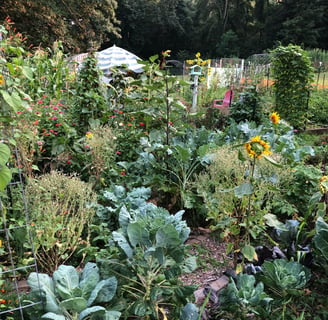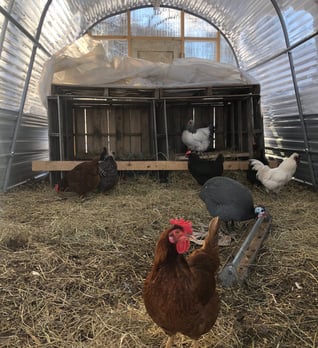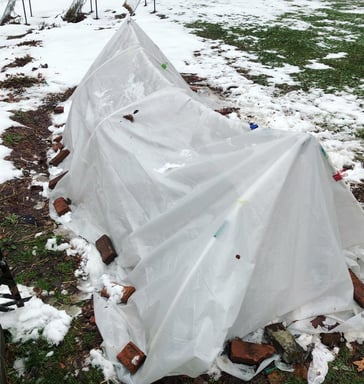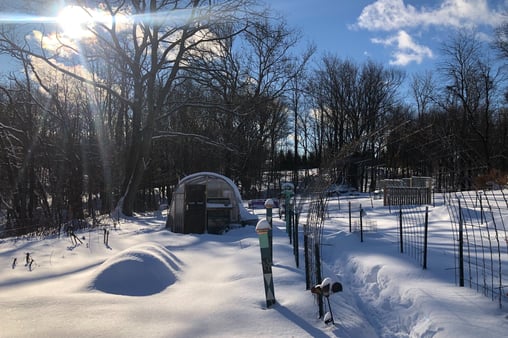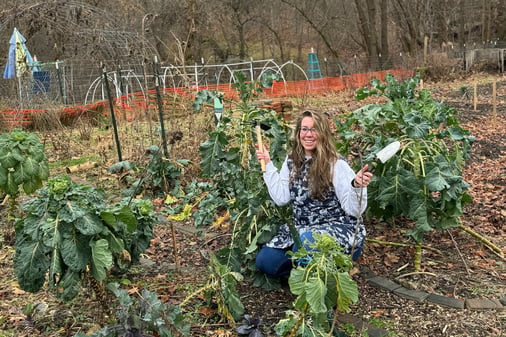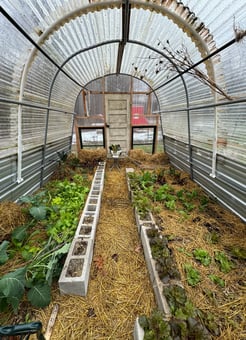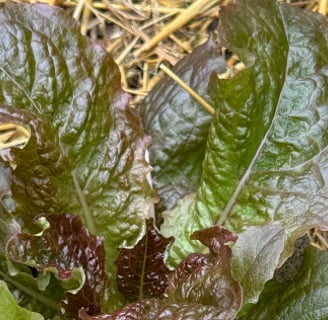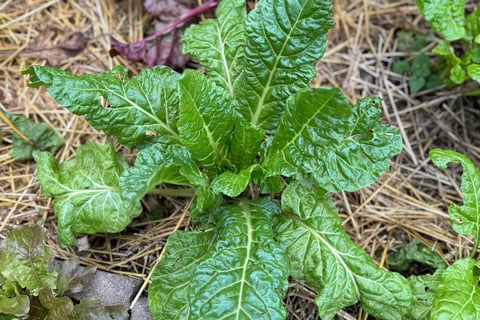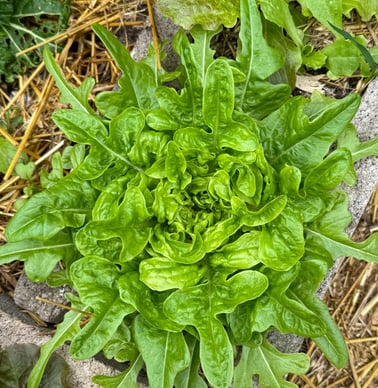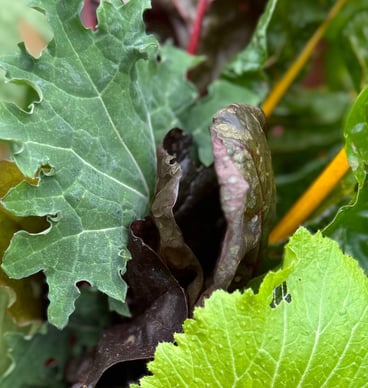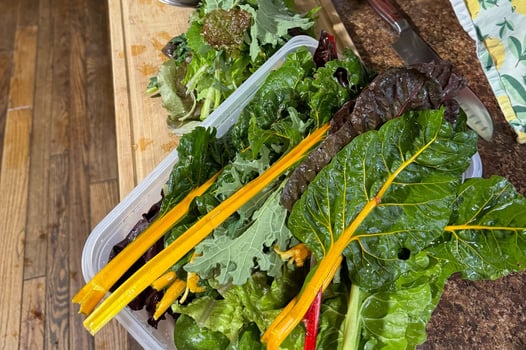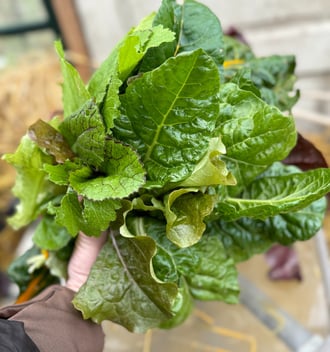Winter's Bounty: Greens For Lunch
Unlock the Winter Harvest: How would you like to walk out your back door in the middle of winter to go pick a salad? Grow fresh, nutrient-rich food all winter long. As I harvest my lunch let me share with you some insights into seasonal planting tips and innovative techniques to cultivate a thriving garden year-round. When we embrace the winter garden we get to enjoy the rewards of homegrown goodness, anytime, anywhere.
WINTER GARDENINGSEASON EXTENSIONNORTHERN GARDENING
Alexa Sandella
1/11/20248 min read
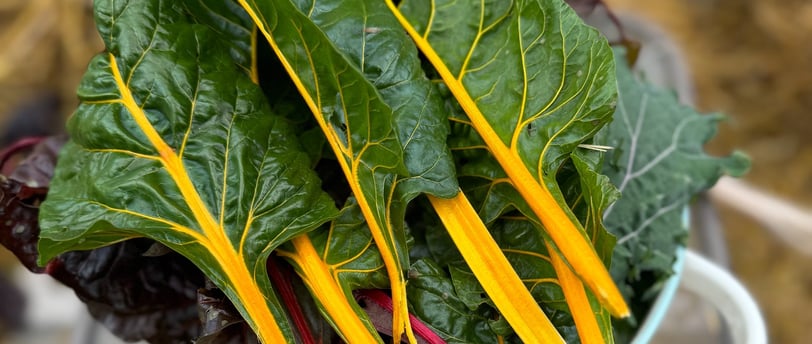

On a chilly, gray overcast January day in Northern Ohio I open my finger print covered stainless steel refrigerator to look for a worn plastic container of salad greens to add to my lunch. I'm having leftover ground beef, roasted chickpeas, homemade sauerkraut, over a bed of greens. Upon examination of the contents of my refrigerator, around the jars of pickled peppers and garlic scapes, a carton of pastured raised eggs, half gallon carton of almond milk, I am saddened to find an absence of greens. "I thought I had some left" I wondered to myself. In a house with 2 teen boys and a hungry husband it's no wonder the salad greens had been eaten. What I thought would be a quick effort to warm up leftovers into a mixed greens bowl was going to take a smidge longer. On its own ground beef, chickpeas, and sauerkraut would taste OK, but I was really craving some greens and color for that meal!
Luckily on this day I didn't have to travel far to obtain the fresh greens I so desired. On this wet and windy January afternoon I put on my brown oversized puffy long winter coat, (that makes me resemble a walking sleeping bag) walked out the back door and about 100 hundred feet to my home vegetable garden where my summer planting efforts (ah summer I miss you) left me with an abundance of greens ripe for the picking, even in January. The tiny seeds I had sown on hot August days when the sun blistered and warmed my tanned skin had germinated and grown into small plants by the time our first frost came.
It's hard to conceptualize sowing seeds in August when the garden is wild with over abundance. Where the harvests of peppers, tomatoes, cucumbers, beans and zucchini are running over and you're filled with gratitude and also anxiety that there are only a few days where this beautiful produce goes from ripe, delicious and savory to browning, rotten mush. Preservation season is a wild ride. Yet in those long working days and short hot nights it is the time to plant the seed if you want to be picking salad greens in January. And boy did I want those greens within steps of my warm cozy house.
This is the third season I have grown a winter garden, each year improving my techniques and timing to get it "just right" for my climate and conditions. This year I am able to grow my salad greens in an un-heated greenhouse my husband and I built as a DIY project in 2021. The last 2 winters we kept our chickens housed in this structure over winter, which worked out extremely well and provided us with lots of rich composted manure to grow in the following summer. We called it our "Chicken Coop Greenhouse." This year we moved our chickens into a new, bigger house that allowed them the winter protection they need from the crazy lake effect snow falls we can get here. That meant mama can finally use her "big" greenhouse overwinter for growing!
Prior to this I constructed low tunnels (hoop tunnels) out of PVC pipe and clear plastic tarps to create a winterized structure for keeping frost hardy plants protected from bitter freezing temperatures. They worked well enough for those seasons, but I did fight with wind blowing them apart and heavy snowfalls collapsing my plastic "tent." If I didn't have a greenhouse option I would continue to use low tunnels to grow my greens in overwinter - however a greenhouse does make it easier.
I provide this structural context because when we are talking about a winter garden in northern climates we have to be prepared for all scenarios. Some years we may see feet upon feet of snow. Others not much snow but consistent temperatures between 0-20 degrees Fahrenheit. If we're lucky it may stay fairly moderate with an occasional snowfall that melts quickly. We just don't know until it comes. By preparing a space for your winter crops to hunker down if things get bad will ensure they don't die off and keep growing, even at a slow pace, for you to enjoy.
Now back to sourcing lunch. I walk into my garden, mixed in shades of green and brown from the plants that are powering through the cold, standing tall and proud (yay brassicas!) and the dead foliage I left behind at Autumns end when I had had enough of garden season. I open the heavy wooden door to my greenhouse and am delighted by the sight of the bright green lettuces, chard, mustard, kale and bokchoy growing amongst the insulating straw nestled around them. Have you ever walked into a commercial greenhouse and inhaled deeply experiencing a unique smell? It's a satisfying smell that I can only explain as warm damp earth and life capsuled in a contained area. My greenhouse smelled like this on this cold January day, giving me a mood boost and a small glimmer of spring. The faded thermometer in the back corner reads 40 degrees F which already is 15 degrees warmer than outside and there is a wind break so my hands and face don't burn from the cold blasting at me otherwise.
Now I get to pick my pretty little greens that I have been so careful to wait for. These little ones get a great head start into their growth as the late summer days are still long and warm and the nights are cool, letting greens thrive and grow strong. But as the daylight shortened towards the winter solstice so did their growth. Timing is everything with the winter garden. Don't plant too early to cause your plants to go to seed. Don't plant too late causing inadequate growth. It's a dance and a balance the most experienced gardener only learns through trial and error.
My greens were planted on the tail end of the "golden window" for winter planting so they were a good size, but not huge or over productive (which we all hope for.) I have been picking the greens sparingly, slowly, letting a week or two pass in between harvests to allow them some time to recover and grow more. As our daylight lengthens now the growth rate will increase as well - given we don't get any crazy low temperatures - it IS only January and February freezes can be brutal.
I pick the outer leaves from each plant, just a little bit at a time, leaving the middle section alone so the greens can continue to receive in sunlight and photosynthesize for growth. By doing this we get a continuous supply of greens, even through the winter, even when people tell you can't grow food. I have a greenhouse, so this is a little easier for me now. But make no mistake that these plants can take a beating out in the elements, unprotected and uncovered.
Plants amaze me year after year what they are able to withstand. Even my giant broccoli trees (they grew big over summer but never headed up!) that remain in my garden now have been through snow storms and 23 degree temperatures, with their leaves turning brown and wilting one day and the next they are green and perky again. You take note each year of what survives and for how long. You plant those again and again and save the seeds if at all possible.
When I have picked enough greens to fill my colander I take a moment to appreciate each unique leaf, the prickly texture of the Chinese cabbage, the silky curves of the red romaine lettuce, the colorful cheery stems of the Swiss chard greeting me with yellow, red, and purple vibrance, the crinkly edges of the kale. When you look out at a gray overcast sky for weeks on end it's easy to feel dull and drab with it, experiencing a heaviness that this season can weigh you down with. The bright green living plants my winter garden teach me that even in the dark days life continues to thrive. May we open our eyes and see what a gift we have when we work with nature.
Satisfied with my bounty I return to my kitchen, colander overflowing with greens just waiting to be prepared for lunch. I give each leaf a rinse (organic gardening means garden surprises, some that I'd prefer not to eat), shake off the excess water, and begin to chop them all up. I find my children are more apt to eat a salad if I've prepared cut greens versus a bowl of giant whole leaves in the fridge!
Now finally I can prepare my lunch. My growling stomach reminds me that I skipped breakfast and it's ready to eat. I take out a colorful ornate bowl from the cupboard and layer my meal. First my fresh chopped salad greens. Then a re-heated portion of ground beef. Next roasted chickpeas for added texture and variety. Last a generous spoonful of my homemade crunchy sour sauerkraut my summer cabbages provided to me.
I could get into a whole other topic of slow food and the experience of waiting months for something to grow then the moment it gets to be enjoyed, but I will save that for another blog. As I reflect on this meal I will say each season I lean into more and more appreciation for this food that I get to make with portions of the harvest coming from the home garden. I'm not trying to grow everything we eat but each thing I can and incorporate makes each bite a little more special.
I like to encourage people to push the limits of their growing season. Sure you can veggie garden for 6 months, May-October in most regions. But what about 10 or 11 months of the year? March or April - January? If you're a little bit south of Ohio even 12 months of the year! The local winter garden provides a portion of the fresh food our bodies crave. Let's normalize this process and challenge what we are told the growing season looks like.
Do something that makes you smile today and keep looking towards the lights in your life.
-Alexa
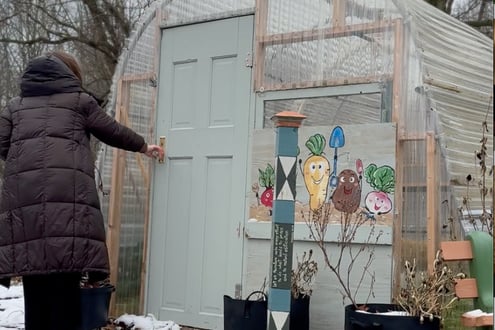

Leave a Comment
What's your favorite winter vegetable to grow, and how do you keep your garden thriving during the colder months?


